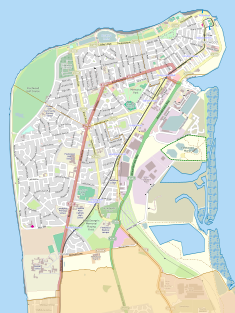Harriet (ship)
| Fleetwood Museum | |
|---|---|
 |
|
| Location | Fleetwood, Lancashire, England |
| Coordinates | 53°55′29″N 3°00′21″W / 53.9247°N 3.0058°WCoordinates: 53°55′29″N 3°00′21″W / 53.9247°N 3.0058°W |
| Built | 1836 |
| Architect | Decimus Burton |
|
Listed Building – Grade II
|
|
| Official name: Wyre Borough Treasurer's and Borough Housing Departments | |
| Designated | 31 March 1978 |
| Reference no. | 1072398 |
Fleetwood Museum is a local history and maritime museum in the English seaside town of Fleetwood, Lancashire. The museum was originally the town's Customs House and, completed in 1836, was one of the first buildings constructed in Fleetwood. Like much of the town it was designed by architect Decimus Burton. The building is now a maritime museum. It has been designated a Grade II listed building by Historic England.
Fleetwood was planned by local landowner Peter Hesketh-Fleetwood who employed Decimus Burton to lay out the town and design many of the buildings. Hesketh-Fleetwood intended his town to be a major port and Burton designed the Customs House as one of the first buildings, completed in 1836. In 1876 it became the private residence of Alexander Carson, who extended the building to the north, and named it "Wyre Holm"; the customs offices were transferred to another building on the same terrace. The building became Fleetwood's Town Hall in 1889. For a short time, it was occupied by a private school and in 1992, it became Fleetwood Museum.
On 31 March 1978, Historic England designated the building a Grade II listed building. The Grade II designation—the lowest of the three grades—is for buildings that are "nationally important and of special interest".
Fleetwood Museum is on two storeys. It is built of sandstone, rendered with roughcast lime plaster. The front façade has eight ranges of sash windows. The building is accessed from the front through two porticos. Both entrances are at the top of stone staircases and flanked by columns—the south entrance by round Doric columns and the north entrance by square columns. Between the two staircases there are iron railings with spear-shaped finials.
...
Wikipedia

